How to look for records of... Companies and businesses
How can I view the records covered in this guide?
How many are online?
- Some
Contents
- 1. Why use this guide?
- 2. Different types of businesses and companies
- 3. What we hold and what we don't hold
- 4. Records of live registered companies
- 5. A company's own records after it ceases trading
- 6. Online records
- 7. How to trace basic company information and search for original documents
- 8. Records of companies dissolved after 1860
- 9. Records of companies dissolved before 1860
- 10. The Register of Business Names, 1917-1982
- 11. Records of chartered companies
- 12. Records of mutual societies and assurance companies
- 13. Records of bankruptcy and liquidation
- 14. Further reading
1. Why use this guide?
This is a guide to the various kinds of company and business records held at The National Archives and how to access them. These are predominantly records of dissolved companies.
You may find better sources for the history of a company or business in a local record office or in a company’s own archive, where they exist.
The National Archives does not hold files for Scottish and Northern Irish registered companies. For these, go to the National Records of Scotland and the Public Record Office of Northern Ireland respectively.
For advice on sources of company and business records beyond The National Archives, see our guide to Company records held in other archives.
2. Different types of businesses and companies
The concept of a business is a very broad one whilst, in legal terms, a company is something more distinct. A company is a legal entity with a separate identity from those who own or run it. All companies are businesses but not all businesses, legally speaking, are companies.
There are numerous different types of companies in the UK and to utilise the records we hold it will help to understand the following concepts and distinctions:
2.1 Incorporation
Incorporation is the process by which a new or existing business registers as a limited company, thus acquiring a specific kind of legal status. Before the Joint Stock Companies Act of 1844 incorporation was only possible by Royal Charter or a private act of Parliament. Since then, registration has been the predominant method.
2.2 Incorporation by registration
Registration, under the various Companies Acts since 1844, has become the most common and the most important form of incorporation. Nearly all commercial companies in the UK nowadays are registered companies, though registration is not required of sole traders.
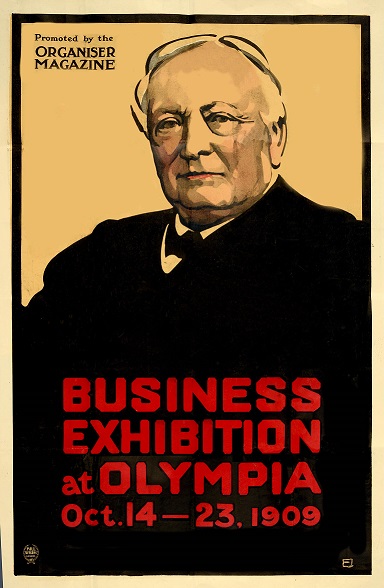
This image (catalogue reference COPY 1/285) was registered with the Copyright Office of the Stationers’ Company. Formed in 1403, the Stationers’ Company was incorporated by Royal Charter in 1557. Purchase a copy of this image from our Image Library.
The 1844 Act established the UK’s first registrar of companies, known as Companies House.
Today, a company can be registered as one of four different types:
- Public limited company (PLC)
- Private company limited by shares (LTD)
- Private unlimited company (UNLTD)
- Private company limited by guarantee
2.3 Incorporation by Royal Charter
Incorporation by Royal Charter, dating back to the medieval period, is now rare, but was once prevalent. It meant that a company’s status was granted by the monarch or the monarch’s representatives.
Chartered companies and organisations still exist, among them the BBC, the Royal Opera House, the British Red Cross and the British Council.
The 1844 Act did not apply to chartered companies.
2.4 Incorporation by Act of Parliament
Companies can still be incorporated by Act of Parliament now but this is rare. They are known as statutory companies.
Statutory companies still operating today include the Port of London Authority, the Post Office and the Independent Television Commission, incorporated by the Broadcasting Act 1990.
The 1844 Act did not apply to statutory companies.
3. What we hold and what we don’t hold
The vast majority of company records held at The National Archives are for dissolved companies which were incorporated by registration. In most cases, they are not a company’s own records but merely the government records of a company’s registration and dissolution.
When a registered company is dissolved, its registration and dissolution files remain at Companies House for twenty years, after which time they are either destroyed or transferred to The National Archives.
Broadly speaking, since the mid-19th century the percentage of company records transferred to The National Archives has steadily reduced to ever smaller proportions of the total as the number of companies registering has increased.
In the main, The National Archives does not hold records created by companies themselves, but there are exceptions to this. In total there are 1,124 companies whose own records can be found in various National Archives departments, mainly:
- former railway companies
- former canal companies
- other transport companies that passed into public ownership
We do not hold many records of chartered companies or statutory companies.
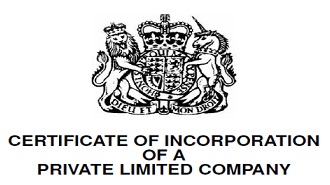
Once a company is registered, a ‘certificate of incorporation’ is issued by Companies House. This confirms the company legally exists and shows the company number and date of formation.
4. Records of live registered companies
The details of live registered companies are held by Companies House. The main responsibilities of Companies House are to:
- incorporate and dissolve limited companies
- register, examine and store company information
- make information available to the public
You can use the Find and update company information service to access basic company information, including:
- the nature of business
- registered office address
- whether the company is live or dissolved
- previous company names
You should contact Companies House for company registrations made under the Limited Partnership Act, 1907 and newspapers registered under the Newspaper Libel and Registration Act, 1881.
All enquiries should be via the Contact Centre tel: 0303 123 4500 or email enquries@companieshouse.gov.uk
5. A company’s own records after it ceases trading
A company’s own records after it is dissolved are often destroyed but may end up as the property of either its creditors or the ex-company directors. Alternatively, they may be sold, inherited by a successor or deposited in an archive, sometimes a local county archive.
When a solvent company is wound up voluntarily by its shareholders or partners, the company’s records remain the property of the ex-company directors.
When a business becomes insolvent and ceases trading its books and papers become the property of its creditors. Registered companies, once insolvent, are legally represented by either a receiver or liquidator. Unregistered partnerships or sole traders are represented by the Official Receiver or trustees appointed by the Court.
6. Online records
None of the records of companies held at The National Archives are available to view online.
However, basic information for live companies is available online through Companies House – see section 4 for more details.
Notices of receiverships, liquidations and bankruptcies appear in the London Gazette, available on The Gazette website.
Browse the University of Leicester’s collection of trade directories for companies and businesses in England and Wales in the 18th, 19th and early 20th centuries.
7. How to trace basic company information and search for original documents
This section provides broad advice on searching for company records in general at The National Archives, as well as suggesting some alternative, easy-to-use sources of basic company information. The subsequent sections of the guide provide advice on more specific record types.
To view almost any of the records of companies held here you will either need to visit us or, where you can identify a specific document reference, order a copy (£). You can use our online catalogue to search for document references.
The registration of companies was first regulated by the Board of Trade and then by its successor departments. These records are found at The National Archives under department code BT. For a sense of the range of documents in the BT department you can browse through the BT divisions and the BT series in our catalogue.
For details of how to search for the records of former railway companies see the Railways research guide.
There are a number of different ways to locate documents for specific companies, some of them explained later in this guide, but the most straightforward ways to perform a broad search are as follows:
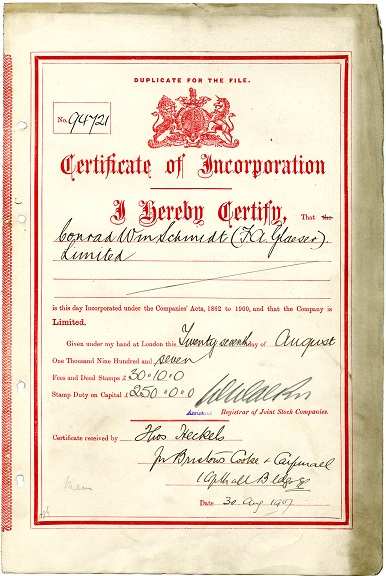
The certificate of incorporation for F A Glaeser Ltd (catalogue reference BT 31/18195/94721), incorporated in 1907. The certificate number (the same thing as the company number) is in the top left-hand corner.
7.1 Search our catalogue by company name
A simple search by the name of a company in our catalogue will often uncover any records we may hold for that company.
7.2 Searching our catalogue by company number
Those records of companies that do not appear in our catalogue under the company name are often identified, instead, by their company number.
When companies register they are issued with certificates of incorporation (see left for an example from 1907), sometimes referred to as certificates of registration. Each certificate has a unique number.
You can find a company’s number either by contacting Companies House (see section 4) or by consulting the printed indexes to company numbers in the reading rooms at The National Archives:
- Indexes of Companies Registered from 17 July 1856 to 30 June 1920 (Volume 1, A-K)
- Indexes of Companies Registered from 17 July 1856 to 30 June 1920 (Volume 2, L-Z)
- Alphabetical Index of Companies on the Register on 30 June 1930
- Alphabetical Index of Companies on the Register on 30 June 1937
The entries in these indexes are arranged alphabetically by the legal title of the company. For example, Joseph Lucas Limited will be under ‘Joseph’ and not under ‘Lucas’.
The date of incorporation is an indication of the range in which a company’s number should appear.
7.3 Use published sources
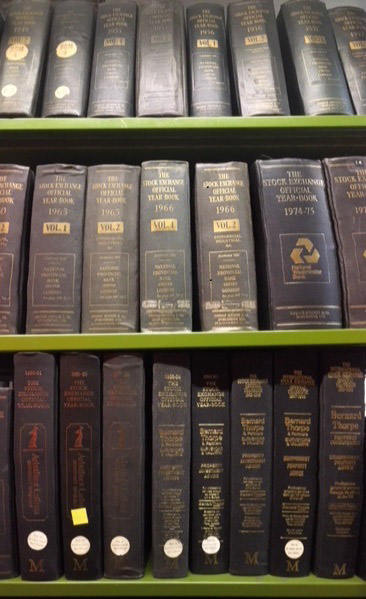 There are several sets of publications, available in The National Archives’ Library, which may prove useful as starting points for tracing the history of some businesses and companies, though none of them provide company numbers. They are:
There are several sets of publications, available in The National Archives’ Library, which may prove useful as starting points for tracing the history of some businesses and companies, though none of them provide company numbers. They are:
- The Stock Exchange Official Year-Book, an annual compilation of all companies quoted on the London Exchange (public companies), including statutory as well as registered companies. We have an incomplete collection from 1909-1990. For each company they include:
- date of incorporation
- business address
- the names of its directors
- a brief note on the nature of the business
- The Register of Defunct Companies Removed from the Year-Book (two volumes up to 1960 and up to 1976-1977). Includes, for each company:
- date of incorporation
- date of dissolution
- Trade directories and in particular the Post Office London Directory (for which we have copies dating back to 1822) and Kelly’s Directories for towns, cities and counties in England and Wales (for which we have copies dating from the 19th century to the 1970s). Many local libraries also have copies of historical trade directories.
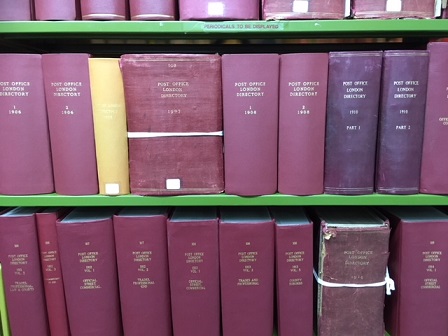
Part of the collection of historical Post Office Directories at The National Archives’ library in Kew.
As well as an alphabetical list of businesses, they contain alphabetical listings of streets, listing all the businesses located on each street. The information for each business is nothing more than:
- business address
- a brief note on the nature of the business
7.4 Search in general correspondence
General correspondence of the Board of Trade covers a broad range of subject matter, some of which relates to individual companies and businesses. There are various records series containing correspondence, which include:
- In-letters, 1791-1863 in BT 1
- Out-letters, 1786-1853 in BT 3
- Correspondence of the Companies Department, 1850-1986 in BT 58
8. Records of companies dissolved after 1860
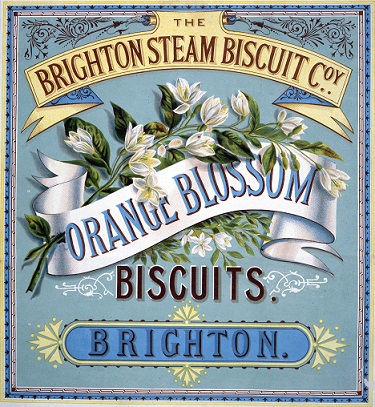
A copyright image (catalogue reference COPY 1/48) of the Brighton Steam Biscuit Company. The dissolution files for this company are in BT 31/2835/15579. Purchase a copy of this image from our Image Library.
Search BT 31 by company name or number for records of companies dissolved since 1860 but before the last 20 years or so. These files do not contain the internal day-to-day business records created by a company itself. Documents are primarily of a legal and procedural nature, usually concerned with the winding-up arrangements prior to the dissolution of a company, and the company’s compliance with the Companies Acts. Documents can include:
- memorandum and articles of association containing particulars of the company’s constitution
- lists and stakes of shareholders
- location of registered office
- register of directors
- annual returns
These files are for a sample of companies only and are not comprehensive. They cover companies dissolved after 1860 and registered since 1856 (in accordance with the Joint Stock Companies Act of 1856).
Whether or not a company appears in these records can depend not only on whether it was selected as part of the sample kept, but on the changes in legislation down the years.
From 1907 some private companies were exempt from a public return of accounts and won’t appear in the records at all. On the other hand, the files for public companies dissolved since 2 July 1960 have all been preserved. For more detail on what is included see the BT 31 series description.
9. Records of companies dissolved before 1860
Search series BT 41 by company name for records of companies dissolved before 1860. The files are likely to include some or all of the following:
- nature of the business
- company address
- names of the company’s promoters and their solicitors
- a prospectus
- details of capital
- issue and allocation of shares
- balance sheets
BT 41 contains the files of all Joint Stock Companies which were registered under the Act of 1844 and dissolved before 1856, and of those re-registered under the 1856 Act and dissolved before 1860.
A sample selection of files for dissolved private companies which were exempt from a public return of accounts have been kept in series BT 95 and are arranged by the date of incorporation and company number ranges. They consist of a set of loose-leaf sheets which include details of the nature of the business.
There is some overlap between BT 41 and BT 31 (see section 8), with about 2,000 companies registered under the 1856 Act appearing in both series.
10. The Register of Business Names, 1917-1982
The Register of Business Names was established in 1916. Its purpose evolved over the years but it was essentially a register of the names of businesses whose trading names differed from that of the business owner or, from 1947, the official company name. This was also the first register in which unincorporated companies such as partnerships and sole traders were listed.
The register was abolished in 1981 but a sample of registration documents for businesses registered in 1916-1917, and every ten years from 1921 until 1981-1982 has been preserved in BT 253.
The nearly 1,300 pieces in the series are arranged in batches of registration numbers and by year. You will need to browse the series to have a hope of finding anything.
11. Records of chartered companies
The only chartered company records held at The National Archives are those of the various colonial chartered companies, such as the British North Borneo Company and the British South Africa Company.
Search for records by company name in our catalogue and use our guides to records of the Foreign Office and Colonial Office for more in-depth research.
Search HO 45 by company name for records of incorporation by Royal Charter. You can also try searches using ‘charter’ and/or ‘incorporation’ as your keywords. The printed version of our catalogue, available only in the reading rooms at Kew, contains a subject heading ‘Charters’ which includes references to the granting of charters to various societies and associations.
Correspondence concerning chartered companies before 1863 is among the records in record series BT 1 (see section 7.4).
12. Records of mutual societies and assurance companies
12.1 Mutual societies
As they were covered by separate legislation, records of mutual societies, which include building societies, friendly societies and industrial and provident societies, are located in a separate record department at The National Archives, whose code is FS.
Browse the several dozen FS series for a sense of what they cover.
You can use the advanced search to search within the whole of the FS department by name of the society. However, the following series require alternative search methods:
| Record description | Record series | Search by |
|---|---|---|
| Statutory documents of friendly societies removed from the register before 1875 or between 1876 -1912 | FS 1 | County and register number. Use indexes in FS 2 and FS 4 to identify register numbers. |
| Statutory documents of friendly societies removed from the register between 1876 -1912 | FS 3 | County and register number. Use indexes in FS 2 and FS 4 to identify register numbers. |
| Annual returns for loan societies | FS 22 | Year |
| Certificates of Registration for Trade Unions | FS 25 | Registration number. Use indexes FS 25/2, 8 and 9 to identify registration numbers. |
For information on the registrations of mutual societies contact the Financial Conduct Authority which operates a Mutual Society Registration.
12.2 Assurance companies
The Board of Trade was also responsible for the regulation of assurance companies.
Use the advanced search to search by assurance company name in BT.
See ACT 1/104 and ACT 1/632 for returns made by assurance companies to the Board of Trade for the period 1912 to 1968.
13. Records of bankruptcy and liquidation
13.1 Official announcements of the bankruptcy and liquidation of companies
Notices of receiverships, liquidations and bankruptcies appear in the London Gazette, available on The Gazette website.
13.2 Bankrupted companies
Among the numerous departments of the Board of Trade and its successors is a Bankruptcy Department.
For Board of Trade records relating to the bankruptcy of firms, search in:
For more guidance on these and related records see our guide to records of Bankrupts and insolvent debtors.
13.3 Court records of the liquidation and winding-up of companies
For court proceedings leading to the liquidation and winding-up of companies search among the records of the:
Actions for the winding-up of companies, as distinct from bankruptcy action, were heard in the Court of Chancery, then from 1873 in the Chancery Division of the Supreme Court of Judicature and from 1890 in the Companies Court. Records of these proceedings are in C 26 (1849-1910), J 13 (1883-1995), J 137 (1924-1981) and J 14 (1891-1989).
Search BT 34 for liquidators’ accounts for companies dissolved between 1890 and 1932.
Other records of the Companies Court are in J 100, J 107 and J 119.
14. Further reading
The following publications are available at The National Archives’ Library.
Francis Goodall, Bibliography of British Business Histories (Ashgate, 2005)
John Orbell, A Guide to Tracing the History of a Business (Phillimore & Co Ltd, 2009)